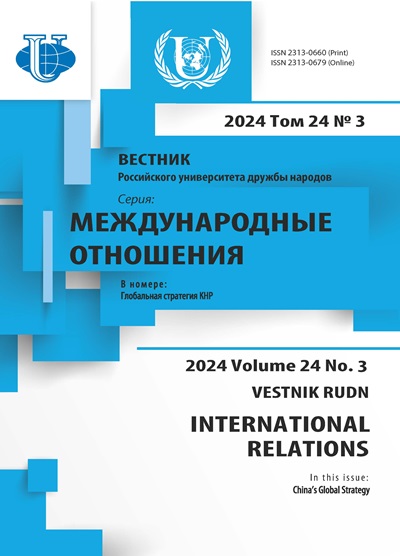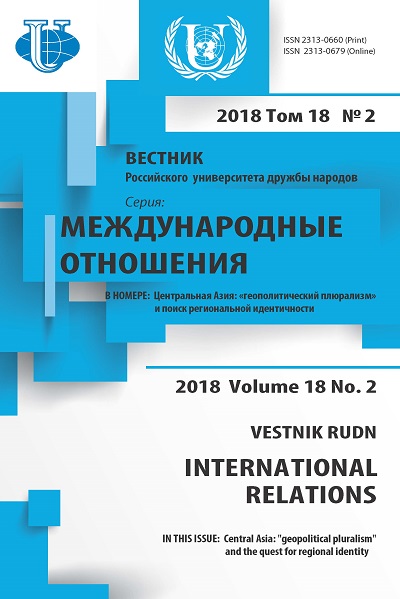THE CENTRAL-ASIAN VECTOR OF THE PAKISTANI FOREIGN ECONOMIC POLICY: PROBLEMS AND PERSPECTIVES
- Authors: Galistcheva N.V.1
-
Affiliations:
- Moscow State Institute of International Relations (MGIMO-University)
- Issue: Vol 18, No 2 (2018): Central Asia: “geopolitical pluralism” and the quest for regional identity
- Pages: 328-341
- Section: INTERNATIONAL ECONOMIC RELATIONS
- URL: https://journals.rudn.ru/international-relations/article/view/18884
- DOI: https://doi.org/10.22363/2313-0660-2018-18-2-328-341
Cite item
Full Text
Abstract
The aim of this article is the analysis of the modern directions of the Pakistani external economic policy in 1990-2000s - its ties with the Central Asian countries. While selecting the research topics the author proceeded from the idea that the problem of the Pakistani cooperation with Central Asian countries has not been comprehensively studied for the last two decades. The research required to attract and summarize a large amount of statistical data that has been drawn from many sources including official-sites of Pakistan and Central Asian countries. The author also used Russian and Pakistani scientific journals and monographs. The article highlights economic cooperation between Pakistan and Central Asian countries: there are statistical data on the index of intensity of mutual Pakistani-Central Asian trade, some information both on investment cooperation between parties and on Pakistani “soft power” in the region. A comprehensive analysis of the Pakistani-Central Asian economic cooperation allows to make several conclusions. Despite some growth in the volume of mutual trade in recent years, its dynamics and nature remain below potential. An important obstacle to the expansion of cooperation in addition to the economic problems in Pakistan and the lack of the common border between it and Central Asia as well as the unstable situation in Afghanistan through which the trade is carried out, are the geopolitical aspirations of the parties. The geopolitical interests of the Central Asian states towards the US, the EU, Japan and Russia reduce the possibility of expanding cooperation between Pakistan and countries of the region. On the other hand the new Great Game unfolding in the region and the participation in it a number of developing states (first of all China, Turkey and Iran) each of which uses an impressive arsenal of funds to consolidate its intensions - from providing humanitarian aid to financing various infrastructure projects, significantly reduces Pakistan’s chances of expanding its presence in the region. The article presents statistical data characterizing the present state of the Pakistan - Central Asia mutual trade at the present time.
About the authors
Natalia Valer’vna Galistcheva
Moscow State Institute of International Relations (MGIMO-University)
Author for correspondence.
Email: galistcheva@yandex.ru
Doctor of Economics, Associate Professor, the Head of the Department of the World Economy of Moscow State Institute of International Relations (MGIMO-University)
References
- Ahmed, M. (2002). South Asia. Crisis of Development. The Case of Bangladesh. Dhaka: The University Press Limited.
- Galistcheva, N.V. (2015). Prospects for a South Asian Economy. Mezhdunarodnye protsessy, 13(3(42)), 40—67. (In Russ.).
- Galistcheva, N.V. (2009). The Economy of the South Asian Countries (India, Pakistan, Bangladesh, Shri Lanka, Maldives, Bhutan. Moscow: MGIMO-University. (In Russ.).
- Galistcheva, N.V. (2015). The Economic cooperation between Pakistan and China. The World and National Economy, 4 (35). URL: http://www.mirec.ru/upload/pdf/2015-02/galistcheva-theeconomic-ties-between-india-and-pakistan.pdf (accessed: 12.02.2018). (In Russ.).
- Zamaraeva, N. (2015). Pakistan and the Central Asia: the new stage but the same aims. URL: https://ru.journal-neo.org/2015/07/17/pakistan-i-tsentral-naya-aziya-novy-j-e-tap-prezhnie-tseli/ (accessed: 12.01.2018). (In Russ.).
- Mukimdjanova, R. (2005). Countries of Central Asia: the Asian Vector of the External Policy. Moscow: Nauchnaia kniga. (In Russ.).
- Chichkin, A. (2017). The gas-pipeline TAPI: the US-China energy front in the Central Asia. URL: http://vpoanalytics.com/2017/07/06/gazoprovod-tapi-energeticheskij-front-ssha-protiv-kitayav-tsentralnoj-azii/ (accessed: 12.02.2018). (In Russ.).
- Irum, Sh. (2011). Importance of Pakistan — Central Asia Relations: Opportunities and Constraints. International Journal of Humanities and Social Science, 1(14), 218—225.
- Mishra, A. (2017). Tajikistan: Pakistan’s Gateway to Central Asia. The Diplomat, 7th August. URL: https://thediplomat.com/2017/08/tajikistan-pakistans-gateway-to-central-asia/ (accessed: 12.02.2018).
- Roy, M.S. (2006). Pakistan’s Strategies in Central Asia. Strategic Analysis, 30 (4), 798—825.
- Singh, S. & Kaur, A. (2014). Connect Central Asia Policy’s Factor in India’s Soft Power Initiatives in CARs: Problems and Perspectives. International Journal of Advanced Research in Management and Social Sciences, 12 (3), 94—114. URL: http://www.garph.co.uk/IJARMSS/Dec2014/8.pdf (accessed: 04.06.2018).
- Zahid, A. (2011). Development of Infrastructural Linkages between Pakistan and Central Asia. South Asian Studies, 26 (1), 103—115.
- Zaidi, Akbar S. (2004). Pakistan’s Economic and Social Development. New Delhi: Rupa.Co.
- Zaidi, Akbar S. (2014). Issues in Pakistan’s Economy. Karachi: Oxford University Press.











